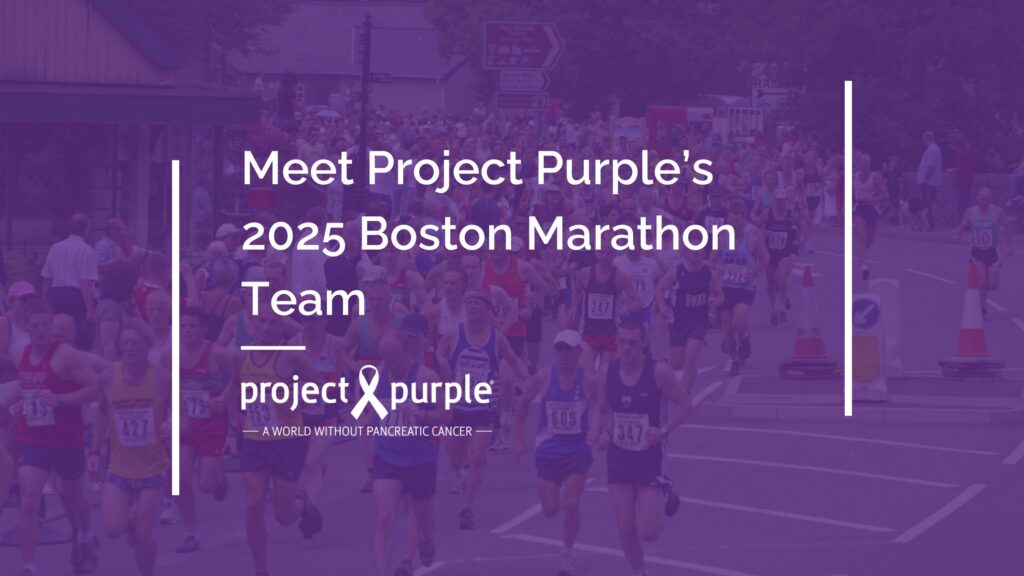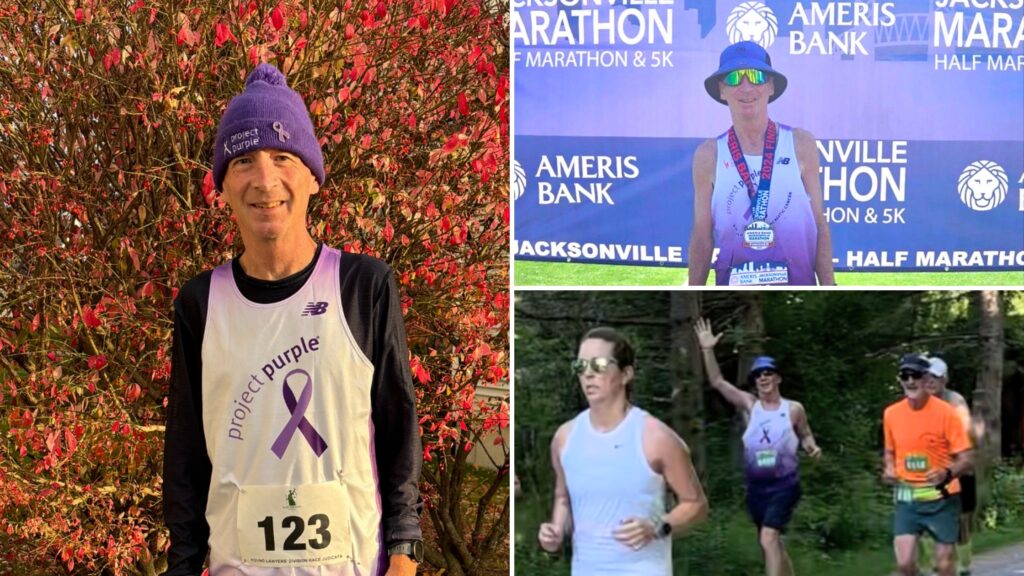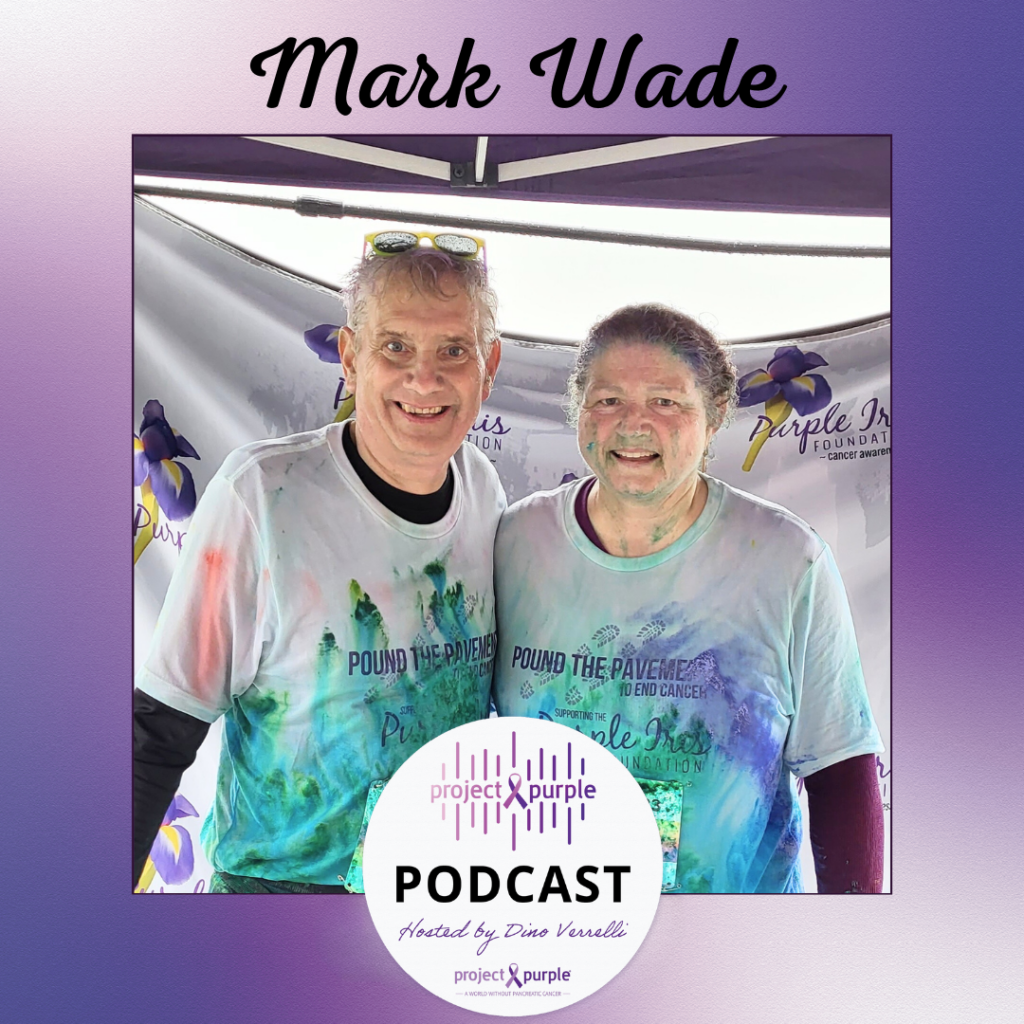Meg and Mark Nicolet met while they were undergraduate students at Hillsdale College in Michigan. Mark played football in college and for a time after, as well. Two of his football coaches had told Mark that one of their top three goals in life was to finish a marathon. Mark’s coaches had a profound influence on his life and their words stuck with him. As the years went by, Mark added “completing a marathon” to his own list of life goals. When Mark’s father Larry was diagnosed with Pancreatic Cancer, Meg suggested that they run a marathon in his honor. The couple wanted to run in celebration and support of a man who continued to thrive in the face of adversity.
Larry Nicolet began experiencing digestive problems in the late fall of 2010. At the time, he was told that it was likely his gallbladder. By March of 2011, he had become very jaundiced. Larry went in to see the doctor and was diagnosed with Pancreatic Cancer. Twelve days later, he had surgery to remove the head of his pancreas. During the surgery, known as the Whipple, the digestive tract is rerouted to accommodate the loss of the pancreatic head. While having the tumor surgically removed is the best chance at providing a cure, only about 15-20% of pancreatic cancer patients are eligible for potentially curative surgeries. So, while the Whipple is major surgery with possible life-long consequences, it provides the best chance of eradicating the cancer.
After undergoing the Whipple, Larry spent his summer receiving chemotherapy. On his one year anniversary from his Whipple, Larry learned that his cancer had returned. This time, he would have to have his entire pancreas removed in a procedure known as a total pancreatectomy. The pancreas serves as both an endocrine and an exocrine gland. As an exocrine gland, the pancreas secretes enzymes which help the body to break down food. As an endocrine gland, the pancreas secretes insulin to help regulate blood sugar levels. After Larry’s pancreas was removed, he instantly became a type 1 diabetic. To regulate his blood sugar levels, Larry had a pump surgically implanted. He has to monitor his blood glucose levels before and after every meal.
At a follow-up appointment, Larry once again learned that he had a cancerous spot in his abdomen. The Nicolet family felt like they had been on a rollercoaster, but every time Larry had gotten bad news, it had been followed up with good news. Larry went through more rounds of chemotherapy. He finished up his treatment in December of 2013. His cancerous spot shrank down to a quarter of its original size and remains stable.
After Larry Nicolet had his original Whipple in March of 2011, he set a goal for himself of playing golf on May 1st. He recovered well enough from his surgery that he was able to fulfill his goal. As he went through chemotherapy, he continued to work and golf. Mark and Meg say that Larry’s experience with Pancreatic Cancer has left him with an amazing sense of gratitude for his family, friends and faith. Though many people suffer significant long-term effects from having the pancreas removed, Mark says, “You would never know that my dad no longer has his pancreas. Dad is the happiest diabetic in America. He never complains and he never says anything negative. He is outgoing, kind, and optimistic in every way. He has been an incredible role model for hope and strength.”
Larry Nicolet’s journey with Pancreatic Cancer and the positive manner in which he has handled his illness inspired Meg and Mark to take action. They decided that their Christmas gift to the family would be to run the New York City Marathon in Larry’s honor for Project Purple.
Meg and Mark had set a fundraising goal of $7000. They are both in their 20s, and they wanted to do some novel things to get their friends to contribute. They designed what they called “The Project Purple Park Olympics”. They got local businesses to kick in prizes to support the games. Restaurants donated meals and a gym donated a month-long membership. The entry fees for the park Olympics went towards their Project Purple fundraising goal. Ten teams ultimately competed in the Park Olympics. They played various games and even had a log roll. It was a fun and creative way to get friends and family together while working toward their goal.
Mark’s background as a football player made him more familiar with lifting heavy weights and doing six second sprints, but his natural athletic ability helped him through the marathon training process. Mark found that he enjoyed the discipline of the training process. He says, “There was a sense of fulfillment that came from training that is different from what I derive from my work”. Meg had run the Chicago Marathon in 2014, and though she does not consider herself to be a serious runner, she knew that she could finish another marathon.
Meg and Mark set goals for their New York City Marathon experience. Their first goal was to raise $7000 for Project Purple. Their second goal was to run the race together. To work towards their second goal, they did most of their training runs together.
With their goals established, the Nicolet family set off for their adventure on the East Coast. Mark and Meg got to carry flags in the parade for the opening ceremonies.
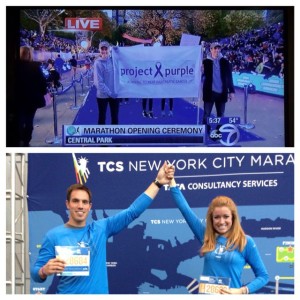
A highlight of their weekend was meeting the other Project Purple families at the team dinner the night before the race. The stories that the families shared with one another served as motivation to give their best effort on race day. The Nicolets felt like they really got to know the heart of the organization over the weekend. Meg and Mark loved the tight-knit, family-like feel of the organization.
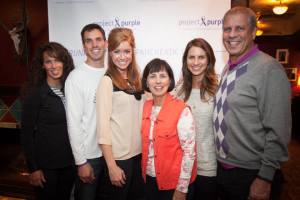
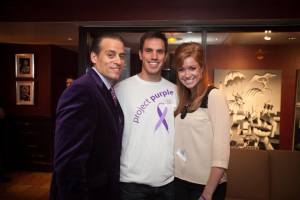
On race morning, Meg and Mark rode the bus to the starting line with Project Purple founder, Dino Verrelli and board member Elli Zadina. While they drove to the start, the four runners shared stories about how pancreatic cancer had impacted their lives.
Mark and Meg had hit their fundraising goal and now they were hoping to achieve their goal of running the marathon together. They fed off of the energy of the other runners and the city itself. There is something special about being able to run through the five boroughs of the city. Runners get to witness the diversity of the neighborhoods and hear people speaking in languages from around the globe. During the marathon, Meg was blown away by what she describes as “the most amazing displays of human kindness.” He felt a sense of unity with the other runners. Mark says, “Everyone has a driving motivation and a story behind what they are doing. It is life-changing.”
The Nicolets ran the first 22 miles of the New York City Marathon together. Meg had some issues with her iliotibial band, so she encouraged Mark to go ahead. They ran almost the entire race together, which is no small feat for a race as long as the marathon. Despite Meg experiencing some pain toward during the final miles, the entire race weekend was a meaningful and memorable for both of the Nicolets.
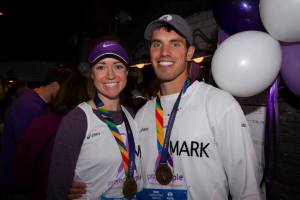
Mark remembers riding the subway at midnight on Halloween over New York City Marathon weekend. The subway was packed with people in crazy costumes. In typical Larry Nicolet fashion, he commented, “If I had not gotten pancreatic cancer, we would not all be in NYC on Halloween!” It is that optimistic viewpoint which has inspired Mark and Meg to run on Larry’s behalf. Mark says, “The whole experience has brought our family together. It has made our family have a better appreciation for how every day is a gift. We have been blessed with a great community of friends and support, and that makes a big difference.”
Meg and Mark currently have a team for Tonia’s Run 5k. You can support their efforts here:
https://www.crowdrise.com/markmegnicolet-ToniasRun2015/fundraiser/markmegnicolet

